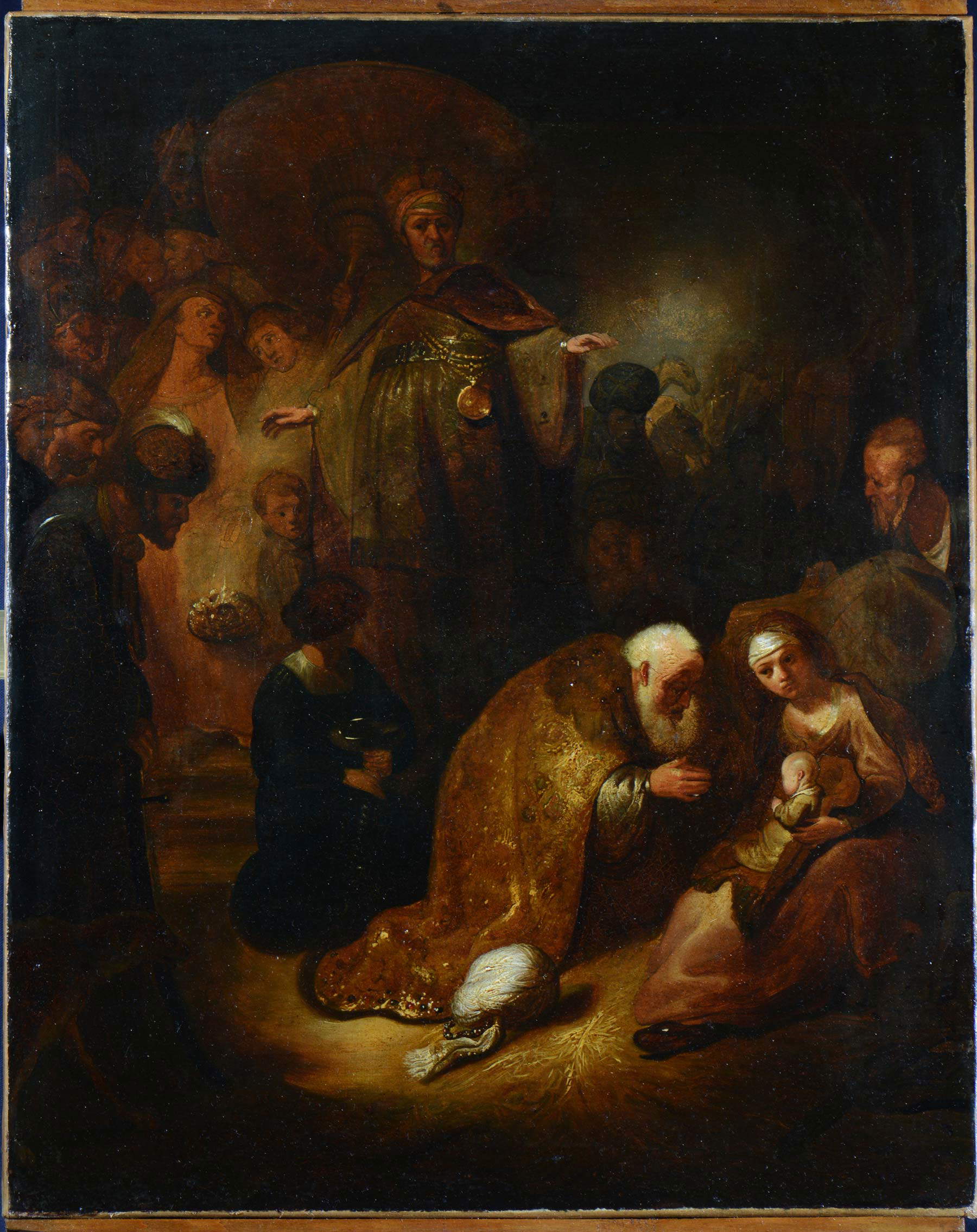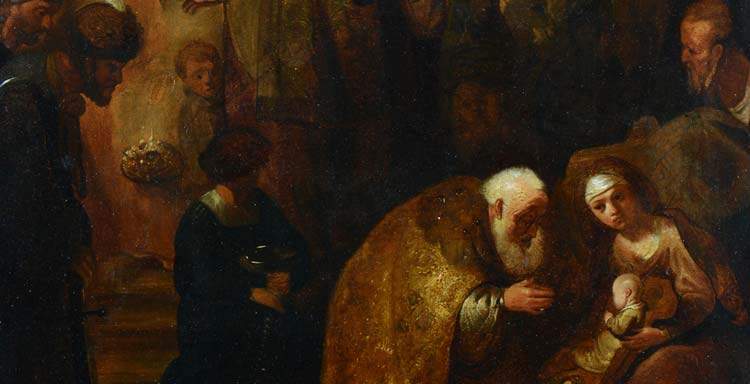Rembrandt's rediscovered Adoration of the Magi goes on display in Florence for the first time
For many years it was forgotten in an art-historical collection dating back to the 16th century and considered lost by scholars. Then the discovery in 2016, careful restorations, and diagnostic investigations: now at last theAdoration of the Magi by Rembrandt (Rembrandt Harmenszoon van Rijn; Leiden, 1606 - Amsterdam, 1669) will be exhibited in Florence, at Palazzo Medici Riccardi. From Dec. 8, 2022 to Jan. 29, 2023, after an extensive research campaign presented at the Villa Medici symposium in June 2021, the painting will be presented to the public for the first time. It will be the focus of the exhibition Studying Rembrandt. Locating the Prototype, Seeing the Invisible. The Adoration of the Magi, promoted by the Metropolitan City of Florence and organized by MUS.E and Associazione MetaMorfosi in collaboration with Fondazione Patrimonio Italia and Fondazione A. Teerlink, which is an opportunity to present, alongside the work, studies and analyses hypothesizing its attribution to Rembrandt, with the direct participation of the Gothenburg Museum of Art.
The work, made in mixed media on paper transferred to canvas, has been “forgotten” for centuries in an art-historical collection dating back to the 16th century. The Rembrandtian prototype of this iconographic subject-to which derivations preserved in Gothenburg and St. Petersburg pertain-had been considered lost by scholars, including the “Rembrandt Research Project” research center. Thanks to the work’s discovery and careful restoration, the Florentine exhibition presents the public with a work that reveals exceptional strength and technique. The painting measures 54 X 43.5 centimeters and the format can be likened to a series of engravings made by Rembrandt on the Infancy and Passion of Christ (54.5 x 44.5 cm).
It is made with the special technique of ink sketch on paper veiled in oil, later applied on canvas. Thanks to the diagnostic analyses carried out on the work, especially investigations using IR infrared reflectography, it was possible to study and analyze wonderful images invisible to the naked eye, which are presented and shared in the exhibition. Visitors to the exhibition, therefore, will thus ideally be able to participate in the ideational phase of the work at the moment when it took shape for the author; at the same time, the public is offered the opportunity to delve into the stylistic, art-historical, and technical elements related to the painting and to understand its relationships with other versions of the work found in Europe. Indeed, the different “passages” of sign in ink, sometimes in brush, the insights, the afterthoughts, made visible by the investigations, testify to the artist’s search for forms and introduce the vision of the work in its present extraordinary beauty. Fundamental in this regard is the comparison of the painting with the Gothenburg and St. Petersburg versions, which, apart from the dimensions and some details, are very similar; by virtue of the comparison of the three versions, some stylistic elements hitherto considered inexplicable are clarified.
The exhibition of theAdoration of the Magi is also an opportunity to reconstruct the story of its accidental and exceptional discovery. The painting, which shows one of the most classical subjects in art history and widely treated by the Dutch painter, is owned by a Roman family and is part of an art historical fund in which there is a strand of Dutch provenance (to which the painting in question belongs). After being accidentally dropped, it underwent restoration in 2016: it was during the cleaning of the work, blackened by antique varnish, that, thanks to the insight and experience of restorer Antonella Di Francesco, the painting emerged in all its sophisticated beauty. From this discovery then began a series of in-depth investigations and specific technical examinations, promoted by the Italian Heritage Foundation and the Teerlink Foundation, which made it possible to verify the work’s constituent elements and to attest to its quality, attributable to Rembrandt himself. In addition to the thematic connection with the series of engravings of identical format, in fact, the studies have allowed to investigate the characteristics of an executive technique that refers to Rembrandt: a rare technique, consisting of an abozzos on paper (executed with brush, pencil or other medium) veiled in oil, with subsequent application on canvas. The drawings brought to light by diagnostic analysis, almost invisible to the naked eye, were made freehand with a very fine wet point, to be later defined in pen. The investigations also reveal the artist’s “regrets” evidenced by the various restorations carried out over the centuries, but above all the presence of a preparatory sketch, not visible to the naked eye but detected by infrared reflectography.

The statements
“We are facing a work of absolute value and interest whose authorship will be ascertained by those who are entitled to do so,” comments Letizia Perini, councilor of the Metropolitan City of Florence delegated to Culture. “The exhibition in Palazzo Medici Riccardi is a non-secondary piece of this path and I like to think that Rembrandt’s footsteps could have reached these Halls sealing integral of this treasure of ours that speaks of the Renaissance, of the attractiveness of Florence as a creative pole of the greatest Western artistic deposit in dialogue with the beauty forged in other countries and in different times.”
“The exhibition of the painting depicting the Adoration of the Magi in Palazzo Medici Riccardi stands as an exemplary opportunity to reflect on two foundational elements of art-historical research,” explains Valentina Zucchi, curator of the museum at Palazzo Medici Riccardi. “The first of these refers to the concepts of execution and attribution of a work, which in the case of Rembrandt’s work appear particularly articulated; the second concerns the importance and value of diagnostic investigations referring to a work of art, indispensable tools for the correct study of an artistic document and for its most appropriate conservation. The exhibition offers the public an opportunity to observe and appreciate a painting of high executive quality, grasping its important peculiarities with respect to technique, composition and style.”
“This is,” explains MetaMorfosi President Pietro Folena, “a new conception of an exhibition, capable of offering the public not only the vision of a masterpiece, but all the reasons and insights that allow its attribution.”
 |
| Rembrandt's rediscovered Adoration of the Magi goes on display in Florence for the first time |
Warning: the translation into English of the original Italian article was created using automatic tools. We undertake to review all articles, but we do not guarantee the total absence of inaccuracies in the translation due to the program. You can find the original by clicking on the ITA button. If you find any mistake,please contact us.




























